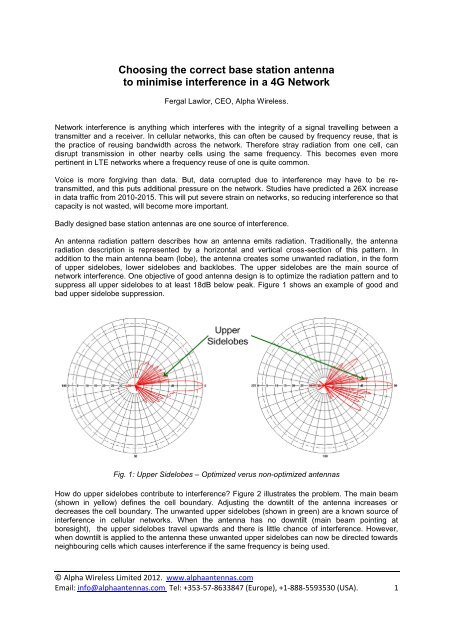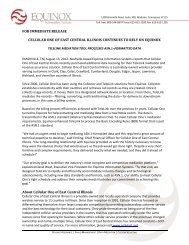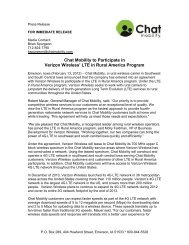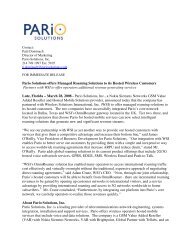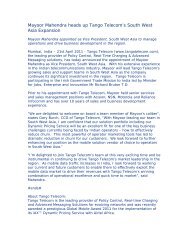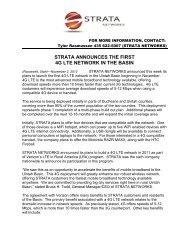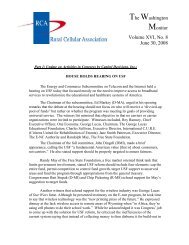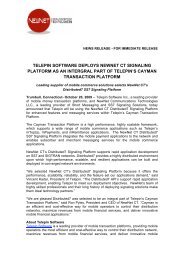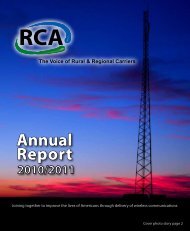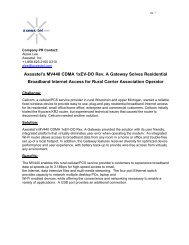Choosing the correct base station antenna to minimise interference ...
Choosing the correct base station antenna to minimise interference ...
Choosing the correct base station antenna to minimise interference ...
You also want an ePaper? Increase the reach of your titles
YUMPU automatically turns print PDFs into web optimized ePapers that Google loves.
<strong>Choosing</strong> <strong>the</strong> <strong>correct</strong> <strong>base</strong> <strong>station</strong> <strong>antenna</strong><br />
<strong>to</strong> <strong>minimise</strong> <strong>interference</strong> in a 4G Network<br />
Fergal Lawlor, CEO, Alpha Wireless.<br />
Network <strong>interference</strong> is anything which interferes with <strong>the</strong> integrity of a signal travelling between a<br />
transmitter and a receiver. In cellular networks, this can often be caused by frequency reuse, that is<br />
<strong>the</strong> practice of reusing bandwidth across <strong>the</strong> network. Therefore stray radiation from one cell, can<br />
disrupt transmission in o<strong>the</strong>r nearby cells using <strong>the</strong> same frequency. This becomes even more<br />
pertinent in LTE networks where a frequency reuse of one is quite common.<br />
Voice is more forgiving than data. But, data corrupted due <strong>to</strong> <strong>interference</strong> may have <strong>to</strong> be retransmitted,<br />
and this puts additional pressure on <strong>the</strong> network. Studies have predicted a 26X increase<br />
in data traffic from 2010-2015. This will put severe strain on networks, so reducing <strong>interference</strong> so that<br />
capacity is not wasted, will become more important.<br />
Badly designed <strong>base</strong> <strong>station</strong> <strong>antenna</strong>s are one source of <strong>interference</strong>.<br />
An <strong>antenna</strong> radiation pattern describes how an <strong>antenna</strong> emits radiation. Traditionally, <strong>the</strong> <strong>antenna</strong><br />
radiation description is represented by a horizontal and vertical cross-section of this pattern. In<br />
addition <strong>to</strong> <strong>the</strong> main <strong>antenna</strong> beam (lobe), <strong>the</strong> <strong>antenna</strong> creates some unwanted radiation, in <strong>the</strong> form<br />
of upper sidelobes, lower sidelobes and backlobes. The upper sidelobes are <strong>the</strong> main source of<br />
network <strong>interference</strong>. One objective of good <strong>antenna</strong> design is <strong>to</strong> optimize <strong>the</strong> radiation pattern and <strong>to</strong><br />
suppress all upper sidelobes <strong>to</strong> at least 18dB below peak. Figure 1 shows an example of good and<br />
bad upper sidelobe suppression.<br />
Fig. 1: Upper Sidelobes – Optimized verus non-optimized <strong>antenna</strong>s<br />
How do upper sidelobes contribute <strong>to</strong> <strong>interference</strong>? Figure 2 illustrates <strong>the</strong> problem. The main beam<br />
(shown in yellow) defines <strong>the</strong> cell boundary. Adjusting <strong>the</strong> downtilt of <strong>the</strong> <strong>antenna</strong> increases or<br />
decreases <strong>the</strong> cell boundary. The unwanted upper sidelobes (shown in green) are a known source of<br />
<strong>interference</strong> in cellular networks. When <strong>the</strong> <strong>antenna</strong> has no downtilt (main beam pointing at<br />
boresight), <strong>the</strong> upper sidelobes travel upwards and <strong>the</strong>re is little chance of <strong>interference</strong>. However,<br />
when downtilt is applied <strong>to</strong> <strong>the</strong> <strong>antenna</strong> <strong>the</strong>se unwanted upper sidelobes can now be directed <strong>to</strong>wards<br />
neighbouring cells which causes <strong>interference</strong> if <strong>the</strong> same frequency is being used.<br />
© Alpha Wireless Limited 2012. www.alpha<strong>antenna</strong>s.com<br />
Email: info@alpha<strong>antenna</strong>s.com Tel: +353-57-8633847 (Europe), +1-888-5593530 (USA). 1
Fig. 2: Effect of Upper Sidelobes<br />
Mentum PLANET is a popular planning and optimization software <strong>to</strong>ol for wireless access networks.<br />
Alpha Wireless used Mentium PLANET <strong>to</strong> analyze <strong>the</strong> effects on a network of using <strong>antenna</strong>s with<br />
optimized upper sidelobe suppression versus using <strong>antenna</strong>s with typical upper sidelobe suppression.<br />
The city of Paris was used as an example of a high density network. Both <strong>the</strong> down<strong>to</strong>wn and<br />
suburban areas were analyzed, and included 809 three-sec<strong>to</strong>r sites.<br />
The performance of both <strong>antenna</strong> types was evaluated by using Mentum PLANET <strong>to</strong> generate<br />
coverage maps of <strong>the</strong> following performance indica<strong>to</strong>rs in both down<strong>to</strong>wn and suburban Paris.<br />
Receive Signal Receive Power (RSRP)<br />
Receive Signal Receive Quality (RSRQ) and or Downlink C/(N+I)<br />
Downlink Average Data Rate<br />
Table 1 summarises <strong>the</strong> improvement in coverage gain for data rates of 42Mbps when<br />
<strong>the</strong> <strong>antenna</strong>s with optimized upper sidelobe suppression were used. Improvements of 40-200% were<br />
achieved. Significant improvements, which can only lead <strong>to</strong> greater user satisfaction.<br />
Optimized<br />
Antenna<br />
(non-covered<br />
area)<br />
Non-optimized<br />
Antenna<br />
(non-covered<br />
area)<br />
Coverage Gain<br />
42Mbps<br />
Down<strong>to</strong>wn<br />
42Mbps<br />
Suburban<br />
13.9% 23% 40%<br />
3.6% 2.1% 70%<br />
1.3% 4.5% 70%<br />
6.5% 2.3% 200%<br />
Table 1: Improvement Summary<br />
For full details on <strong>the</strong> study see <strong>the</strong> white paper at<br />
http://www.alpha<strong>antenna</strong>s.com/documents/USLS.pdf.<br />
Your <strong>base</strong> <strong>station</strong> <strong>antenna</strong> choice can impact on <strong>the</strong> efficiency of your network. Inadequate upper<br />
sidelobe suppression in an <strong>antenna</strong> design can lead <strong>to</strong> increased <strong>interference</strong>, which can only result<br />
in less and more dissatisfied network users. In this study, a large city network was analysed using<br />
both optimised and non-optimised <strong>antenna</strong> parts, and gains in coverage area from 40-200% were<br />
achieved using <strong>antenna</strong>s with optimised radiation patterns.<br />
© Alpha Wireless Limited 2012. www.alpha<strong>antenna</strong>s.com<br />
Email: info@alpha<strong>antenna</strong>s.com Tel: +353-57-8633847 (Europe), +1-888-5593530 (USA). 2


